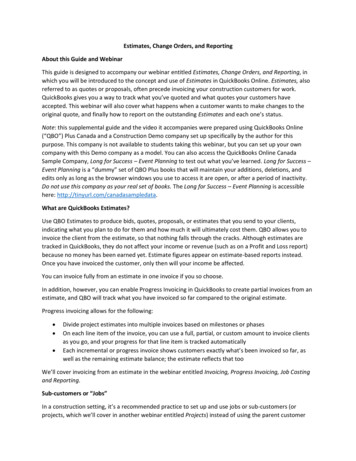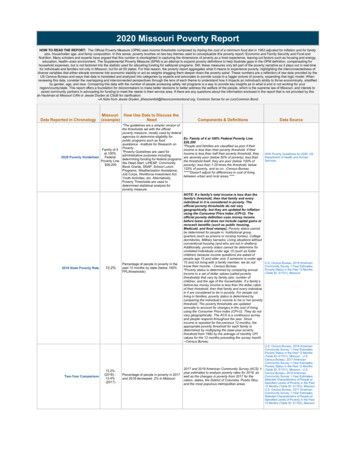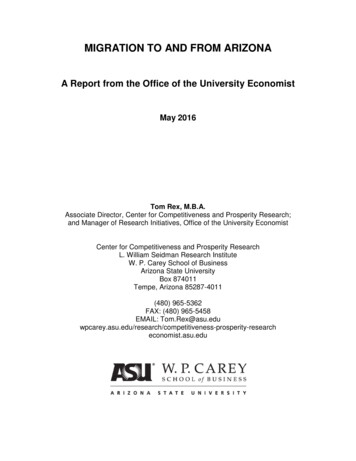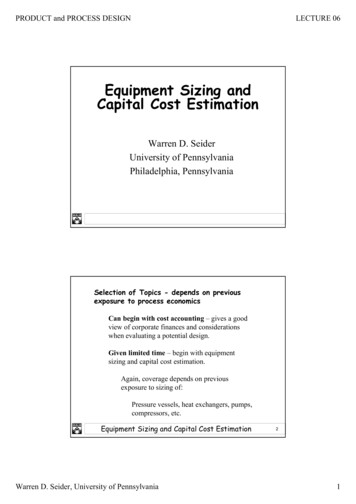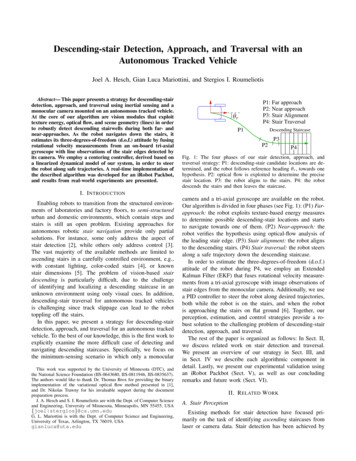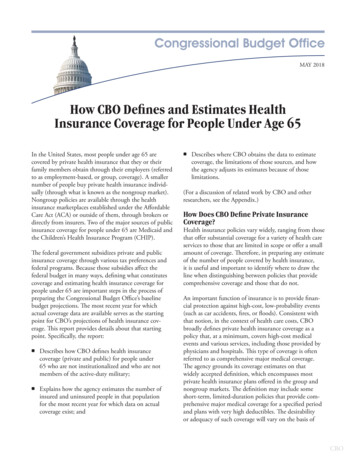
Transcription
May 2018How CBO Defines and Estimates HealthInsurance Coverage for People Under Age 65In the United States, most people under age 65 arecovered by private health insurance that they or theirfamily members obtain through their employers (referredto as employment- based, or group, coverage). A smallernumber of people buy private health insurance individually (through what is known as the nongroup market).Nongroup policies are available through the healthinsurance marketplaces established under the AffordableCare Act (ACA) or outside of them, through brokers ordirectly from insurers. Two of the major sources of publicinsurance coverage for people under 65 are Medicaid andthe Children’s Health Insurance Program (CHIP).The federal government subsidizes private and publicinsurance coverage through various tax preferences andfederal programs. Because those subsidies affect thefederal budget in many ways, defining what constitutescoverage and estimating health insurance coverage forpeople under 65 are important steps in the process ofpreparing the Congressional Budget Office’s baselinebudget projections. The most recent year for whichactual coverage data are available serves as the startingpoint for CBO’s projections of health insurance coverage. This report provides details about that startingpoint. Specifically, the report: Describes how CBO defines health insurancecoverage (private and public) for people under65 who are not institutionalized and who are notmembers of the active- duty military; Explains how the agency estimates the number ofinsured and uninsured people in that populationfor the most recent year for which data on actualcoverage exist; and Describes where CBO obtains the data to estimatecoverage, the limitations of those sources, and howthe agency adjusts its estimates because of thoselimitations.(For a discussion of related work by CBO and otherresearchers, see the Appendix.)How Does CBO Define Private InsuranceCoverage?Health insurance policies vary widely, ranging from thosethat offer substantial coverage for a variety of health careservices to those that are limited in scope or offer a smallamount of coverage. Therefore, in preparing any estimateof the number of people covered by health insurance,it is useful and important to identify where to draw theline when distinguishing between policies that providecomprehensive coverage and those that do not.An important function of insurance is to provide financial protection against high- cost, low- probability events(such as car accidents, fires, or floods). Consistent withthat notion, in the context of health care costs, CBObroadly defines private health insurance coverage as apolicy that, at a minimum, covers high- cost medicalevents and various services, including those provided byphysicians and hospitals. This type of coverage is oftenreferred to as comprehensive major medical coverage.The agency grounds its coverage estimates on thatwidely accepted definition, which encompasses mostprivate health insurance plans offered in the group andnongroup markets. The definition may include someshort- term, limited- duration policies that provide comprehensive major medical coverage for a specified periodand plans with very high deductibles. The desirabilityor adequacy of such coverage will vary on the basis of
2 How CBO Defines and Estimates Health Insurance Coverage for People Under Age 65people’s preferences and income but that does not changeCBO’s definition of coverage. The definition excludesthe following: policies with limited insurance benefits(known as mini- med plans); some types of short- term,limited- duration policies and long- term policies thatdo not provide comprehensive major medical coverage;“dread disease” policies that cover only specific diseases;supplemental plans that pay for medical expenses thatanother policy does not cover; fixed- dollar indemnityplans that pay a certain amount per day for illness orhospitalization; and single- service plans, such as dental- only or vision- only policies.When specific requirements are established in law, CBOtakes into account those definitions to further determinewhat policies count as private insurance coverage. Todefine coverage under the ACA, CBO relies on provisions in that law that established detailed requirementsgoverning the benefits of private insurance coverage inthe large- group market, which is generally defined asemployers with more than 50 employees.CBO also takes into account separate provisions ofthe ACA that define the requirements governing plansoffered in the small- group market (generally defined asemployers with up to 50 employees) and the nongroupmarket. Since 2014, new plans sold in those marketsmust cover 10 categories of health care benefits thatthe ACA defines as essential. Other provisions requirethat those plans’ actuarial value (a summary measure ofthe depth of coverage) fall into specified categories (anactuarial value of 60 percent, 70 percent, 80 percent,or 90 percent). In limited circumstances, plans withan actuarial value of less than 60 percent—known ascatastrophic plans—can be sold to certain individuals.(A plan with an actuarial value of 60 percent meansthat, for an average population, the plan will pay for60 percent of covered health care expenses; enrollees areresponsible for 40 percent of their health care expensesthrough some combination of deductibles, copayments,and coinsurance.) Some plans that existed before 2014and are still being offered are exempt from those requirements or from certain ACA regulations. CBO countsthose noncompliant plans and catastrophic plans asprivate insurance coverage because they typically providecomprehensive major medical coverage and are permitted under the ACA in limited circumstances.May 2018If the provisions of the ACA that govern the definitionof private insurance coverage were amended or if changesin regulations allowed more noncompliant plans to besold, CBO would take those new laws and regulationsinto account when defining coverage. But the agencywould continue to exclude plans that did not providethe minimum benefits afforded by comprehensive majormedical coverage. In the absence of any definition, CBOwould revert to the widely accepted definition of private insurance coverage—comprehensive major medicalcoverage with a minimum level of benefits, as describedabove. That definition of private insurance coverage isin keeping with what the agency has used to estimatecoverage in the past.How Does CBO Define Public InsuranceCoverage?CBO defines as publicly insured people who receivefull Medicaid or CHIP benefits. The agency’s definition of publicly insured does not include people whoreceive partial Medicaid benefits—such as women whoreceive only family planning services or unauthorizedimmigrants who receive only emergency services. CBOalso defines as publicly insured disabled adults underage 65 who are covered by Medicare. Additionally,CBO considers TRICARE policyholders and theirdependents to be publicly insured (although active- dutymilitary personnel are not included in the population forwhich CBO estimates insurance coverage). Moreover,CBO defines as publicly insured people who use theIndian Health Service (IHS) or the Veterans HealthAdministration (VHA). Lastly, CBO defines othermiscellaneous sources of coverage, including studenthealth plans and coverage from foreign sources, as healthinsurance.What Data Sources Does CBO Use toEstimate Coverage?To estimate the number of people with and withouthealth insurance coverage, CBO combines data fromhousehold and employer surveys with administrativedata about the operation of government programs (whenavailable). CBO currently uses survey data as the basisfor estimating employment- based private insurance coverage. The agency also uses survey data to estimate thenumber of people without coverage because no administrative data on the uninsured are available. By contrast,CBO relies on administrative data from the Centers
May 2018How CBO Defines and Estimates Health Insurance Coverage for People Under Age 65for Medicare & Medicaid Services (CMS) to estimatethe number of people with private insurance coveragein the health insurance marketplaces. Similarly, CBOrelies primarily on data from administrative records tocount people with public insurance coverage throughMedicaid, CHIP, and Medicare.Certain administrative records, such as those that recordprogram participation, are generally more accurate thanreports from household surveys because they are basedon complete tabulations instead of a sample and programfunding is based on them. In addition, survey respondents typically misreport their sources of coverage tosome degree. Survey data, however, are used to determinethe demographic and income characteristics of Medicaidand CHIP enrollees because that information is lackingin administrative data. Survey data can thus fill in thegaps by providing estimates for types of coverage that arenot included in administrative data or by showing howcoverage varies on the basis of demographic variables,such as income and age.To estimate the number of people with private insurance coverage or without coverage, CBO uses datafrom several household surveys: the National HealthInterview Survey (NHIS); the Medical ExpenditurePanel Survey (MEPS)—Household Component; andthe Current Population Survey (CPS). The agencyalso uses data from one employer survey, the MEPS—Insurance Component. All of those surveys are used toestimate how public insurance coverage varies on thebasis of demographic variables. In addition, CBO usesthe Census Bureau’s Survey of Income and ProgramParticipation (SIPP) as the base data in its HealthInsurance Simulation Model (HISIM). (In the nextgeneration of its microsimulation model, now underdevelopment, CBO will use the CPS as its base data.)CBO uses the SIPP as the base data in HISIM becauseit includes detailed information about individuals andfamilies, such as demographic characteristics, income,health status, employment status, insurance coverage, and employers’ offers of insurance. That detailedinformation allows CBO to make coverage projections for current and future years, and it supports thesimulation of behavioral responses of individuals andfamilies to changes in policy and the resulting changesin coverage.The SIPP data alone, however, do not accurately indicatethe extent of current insurance coverage. That is becausesurvey respondents can misreport their sources of coverage and more recent data on insurance coverage are available from other sources. As a result, CBO adjusts theSIPP data to match coverage estimates developed from acombination of administrative data and other householdand employer surveys (as discussed below). CBO takesthat step so that its estimates of historical coverage reflectthe most recent year for which data on actual coveragedistributions exist; the estimates serve as the startingpoint for the development of future projections.What Are the Challenges in Using SurveyData to Estimate Coverage?The main challenge in using household survey data toestimate the number of people with and without healthinsurance coverage involves measurement. Importantaspects include the following: Errors in the reporting of coverage status, Different reference periods (or reporting windows)across surveys, and A lack of information on the depth and extent ofprivate insurance coverage.Errors in the Reporting of Coverage StatusThe potential for error on the part of respondents inreporting their insurance coverage is always present inhousehold surveys, but it can depend, in part, on theway the survey questions are structured. For example,some surveys ask whether anyone in the household hadcoverage, whereas others ask whether each person in thehousehold (by name) had coverage.Data in the household surveys used by CBO and listedabove substantially undercount the number of peoplewith coverage through Medicaid and CHIP because ofmisreporting. Methodological research suggests that thereason for the undercount is that some respondents confuse those public insurance programs with other types ofcoverage, such as private insurance. Also, some peopleappear not to report having public insurance coveragebecause of the stigma associated with receiving publicassistance. To correct for those measurement problems,CBO uses administrative data to count enrollees inMedicaid and CHIP.3
4 How CBO Defines and Estimates Health Insurance Coverage for People Under Age 65Different Reference PeriodsThe reference period also varies across the surveys listedabove. Some surveys ask respondents about their coverage at a particular point in time, such as on the date ofthe interview or during the previous few months. Othersurveys ask respondents about their coverage at any timeduring the previous calendar year. The length of thereference period and the time that has elapsed since thatreference period (the recall period) can affect the accuracy of respondents’ answers. The more time that haspassed since the reference period, the more difficult it isfor respondents to correctly recall their coverage status.Furthermore, the different reference periods might affectestimates of the number of people with and withoutcoverage. For example, the number of people who areuninsured at any time during the year is generally higherthan the number of people uninsured at a specific pointduring the year, which, in turn, is higher than the number of people uninsured for the entire year.A related issue is that different reference periods mightaffect estimates of the number of people with specifictypes of coverage. In surveys that ask about coverageat any time during the year or over a certain period,respondents have the potential to report more than onetype of coverage (such as employment- based coverage orMedicaid). That approach can generate higher estimatesfor specific types of coverage because many people mayhave different sources of coverage or temporary lapses incoverage throughout the year, such as between jobs.Lack of Information on Private Insurance CoverageAnother challenge with household survey data is thatthey provide very little information on the depth andextent of private insurance coverage—in terms of thescope of benefits, the level and structure of cost sharing,and the actuarial value of plans. Although that information is lacking for households, some total statistics onthe depth and extent of private insurance coverage in theemployment- based market are available. The Agency forHealthcare Research and Quality has begun to publishsuch data from the MEPS—Insurance Component (asurvey of private and state and local government employers). For policies in the health insurance marketplaces,detailed information about the scope of benefits, theamount and structure of cost sharing, and the actuarialvalue of plans is publicly available.May 2018In addition to those measurement challenges, there isoften a delay between when survey data are collectedand when they are made available. The delay can be evenlonger if respondents are asked to report on their insurance coverage for a time before the date of collection,such as the previous year.What Are the Challenges in UsingAdministrative Data to Estimate Coverage?Using administrative data to estimate the number of people with health insurance coverage presents three mainchallenges. The first is the delay between the measurement period and the availability of the data. The secondis that most sources of administrative data lack detailedinformation about a person’s demographic characteristics, such as income and employment status. The third isthat administrative data from multiple sources have thepotential to misreport or overstate coverage. For example, the data might double- count people who have morethan one insurance policy within a state or who sign upfor coverage in more than one state during a given year.How Does CBO Estimate the Number ofPeople With Private Insurance Coverage?CBO uses data from the MEPS—Insurance Componentas a benchmark to estimate the number of employment- based private insurance policyholders. CBO then adjuststhat benchmark to incorporate federal employees’ healthcare coverage (because data from the MEPS—InsuranceComponent do not include federal agencies). CBOuses the MEPS—Insurance Component because it isbased on employer responses rather than householdresponses. CBO supplements those data with an estimateof the average number of dependents covered by eachemployment- based policy from the MEPS—HouseholdComponent. In future years, CBO may incorporateadministrative data from 1095 tax forms that count thenumber of people with employment- based coverage.Estimating private insurance coverage for the nongroupmarket has become much easier following enactment ofthe ACA. Since the establishment of the health insurance marketplaces, CMS has collected administrativedata that CBO uses as a benchmark of total enrollmentin the marketplaces. To estimate enrollment in thenongroup market outside of the marketplaces, CBOprimarily uses administrative data from insurance filingswith CMS and similar data compiled by the NationalAssociation of Insurance Commissioners.
May 2018How CBO Defines and Estimates Health Insurance Coverage for People Under Age 65How Does CBO Estimate the Number ofPeople With Public Insurance Coverage?CBO uses data from two sources to estimate publicinsurance coverage provided through Medicaid andCHIP. To count enrollees in those programs, CBO usesadministrative data submitted by the states to CMS.Those data provide the most accurate counts of publicinsurance coverage because people often misreport thatcoverage in household surveys. To determine the demographic and income characteristics of those Medicaidand CHIP enrollees, CBO uses household survey datafrom the SIPP.CBO then adjusts the administrative data to bettermatch its definition of public insurance coverage. Forexample, CBO excludes people who receive only partial Medicaid benefits. But even though those enrolleesare not considered covered by Medicaid—as definedby CBO for purposes of determining public insurancecoverage—they are included in CBO’s counts of totalMedicaid enrollment and spending.Furthermore, CBO counts only people who are actuallyenrolled in Medicaid and CHIP when estimating coverage in those programs. Some people argue that individuals who are eligible for, but not enrolled in, public programs should be counted as insured because those peoplecould enroll at any time. CBO does not count as coveredpeople who are eligible for, but not enrolled in, Medicaidand CHIP because they do not generate federal spendingfor those programs.CBO uses administrative data from CMS and theSocial Security Administration to estimate the numberof people under age 65 who have Medicare coverage.Those data include counts of Medicare enrollees by agegroup and eligibility category, which allows the agencyto estimate the number of enrollees who are under theage of 65.To estimate the number of people with coverage throughTRICARE, IHS, VHA, and other miscellaneous sources,CBO also uses data from the SIPP. However, to assess theaccuracy of those estimates, the agency compares themwith the NHIS and MEPS—Household Component.How Does CBO Estimate the Number ofPeople Without Health Insurance Coverage?The only reliable information about the number ofpeople without health insurance coverage comes fromfederal surveys, and there is no single, definitive surveyfor measuring that population. For a variety of reasons,CBO uses data from the NHIS as its primary benchmarkfor estimates of the number of people who are uninsured. Those data are available more quickly than datafrom other surveys; and, because they are generated froma larger sample, they provide more reliable estimates ofthe uninsured. (Previously, CBO placed greater weighton the MEPS—Household Component.) Also, becausethe NHIS samples households continuously throughoutthe year and includes a question about insurance statuson the day each household is surveyed, it produces themost accurate measure of the average number of peopleuninsured over the course of the year. The data moreclosely correspond to the concept of average enrollmentthat underlies CBO’s projections.Although CBO uses the NHIS as its primary benchmark for the uninsured, the agency also compares thatbenchmark to estimates from the MEPS—HouseholdComponent and the CPS, taking into account thestrengths and weaknesses of those surveys, to continuallyevaluate the accuracy of the NHIS and better understandtrends over time in the number of uninsured.5
Appendix: Related ResearchFrom the Congressional Budget OfficeFor CBO’s most recent projections of health insurancecoverage for people under age 65, see CongressionalBudget Office, Federal Subsidies for Health InsuranceCoverage for People Under Age 65: 2017 to 2027(September 2017), www.cbo.gov/publication/53091.For a discussion of the ways in which CBO wouldestimate health insurance coverage under alternative proposals, see Susan Yeh Beyer and Jared Maeda,“Challenges in Estimating the Number of People WithNongroup Health Insurance Coverage Under Proposalsfor Refundable Tax Credits,” CBO Blog (December 20,2016), www.cbo.gov/publication/52351.For more information about the methods that CBOuses to make its projections of health insurance coverage, see Congressional Budget Office, “The HealthInsurance Simulation Model Used in Preparing CBO’s2018 Baseline” (February 2018), www.cbo.gov/publication/53592; and How CBO and JCT Analyze MajorProposals That Would Affect Health Insurance Coverage(February 2018), www.cbo.gov/publication/53571.For a discussion of various aspects of the private healthinsurance market, including the minimum value standard used to govern benefits in the large-group market, see Congressional Budget Office, Private HealthInsurance Premiums and Federal Policy (February 2016),www.cbo.gov/publication/51130.This report is an update to a previous blog post on thistopic. See Jared Maeda and Susan Yeh Beyer, “How DoesCBO Define and Estimate Health Insurance Coveragefor People Under Age 65?” CBO Blog (December 20,2016), www.cbo.gov/publication/52352. For relatedearlier discussion, see Congressional Budget Office, HowMany People Lack Health Insurance and For How Long?(May 2003), www.cbo.gov/publication/14426.From Other SourcesThe following studies discuss issues in estimating publicand private insurance coverage using survey and administrative data.Jean M. Abraham, Pinar Karaca-Mandic, and MichaelBoudreaux, “Sizing Up the Individual Market for HealthInsurance: A Comparison of Survey and AdministrativeData Sources,” Medical Care Research and Review,vol. 70, no. 4 (August 2013), pp. 418–433, https://tinyurl.com/y7kea80g.Frederic Blavin and others, “An Early Look at Changesin Employer-Sponsored Insurance Under the AffordableCare Act,” Health Affairs, vol. 34, no. 1 (January 2015),pp. 170–177, https://tinyurl.com/yd57mbho.Michael H. Boudreaux and others, “Measurement Errorin Public Health Insurance Reporting in the AmericanCommunity Survey: Evidence From Record Linkage,”Health Services Research, vol. 50, no. 6 (December 2015),pp. 1973–1995, https://tinyurl.com/ycntdo5p.Kathleen T. Call, “Validating Self-Reported HealthInsurance Coverage: Preliminary Results on CPS andACS (Cross-Post),” Blog & News (State Health AccessData Assistance Center, May 2016), http://tinyurl.com/jsbbvbo.Kathleen T. Call and others, “Medicaid Undercountand Bias to Estimates of Uninsurance: New Estimatesand Existing Evidence,” Health Services Research, vol. 43,no. 3 (June 2008), pp. 901–914, https://tinyurl.com/y9gqh43o.Joel C. Cantor and others, “The Adequacy of HouseholdSurvey Data for Evaluating the Nongroup HealthInsurance Market,” Health Services Research, vol. 42,no. 4 (August 2007), pp. 1739–1757, https://tinyurl.com/yb6mg6oe.
APPENDIXHow CBO Defines and Estimates Health Insurance Coverage for People Under Age 65Gary Claxton and others, “Health Benefits in 2014:Stability in Premiums and Coverage for EmployerSponsored Plans,” Health Affairs, vol. 33, no. 10(October 2014), pp. 1851–1860, https://tinyurl.com/yawot5eh.Gary Claxton and others, Measuring Changes in InsuranceCoverage Under the Affordable Care Act, Data Note(Henry J. Kaiser Family Foundation, April 2014), http://tinyurl.com/z39wo6b.Gary Claxton and others, How Many People HaveNongroup Health Insurance? Issue Brief (Henry J. KaiserFamily Foundation, December 2013), http://tinyurl.com/jf7penx (PDF, 403 KB).Michael Davern and others, “An Examination of theMedicaid Undercount in the Current PopulationSurvey: Preliminary Results From Record Linking,”Health Services Research, vol. 44, no. 3 (June 2009),pp. 965–987, https://tinyurl.com/yc6bgywl.Michael Davern and others, “Validating HealthInsurance Coverage Survey Estimates: A Comparisonof Self-Reported Coverage and Administrative DataRecords,” Public Opinion Quarterly, vol. 72, no. 2(Summer 2008), pp. 241–259, www.jstor.org/stable/25167624.Katherine Hempstead, Preliminary Look at Some CarrierData on Enrollment in the Non-Group Market (RobertWood Johnson Foundation, June 2014), https://tinyurl.com/y9qkkon9 (PDF, 417 KB).Pinar Karaca-Mandic and Jean M. Abraham, Using DataFrom the National Association of Insurance Commissioners forHealth Reform Evaluation, State Health Reform AssistanceNetwork Issue Brief (Robert Wood Johnson Foundation,July 2013), http://tinyurl.com/hukzr12 (PDF, 275 KB).Pinar Karaca-Mandic and others, “Going Into theAffordable Care Act: Measuring the Size, Structure, andPerformance of the Individual and Small Group Marketsfor Health Insurance,” in Ana Aizcorbe and others, eds.,Measuring and Modeling Health Care Costs (University ofChicago Press, 2018), pp. 419–456, http://papers.nber.org/books/aizc13-1.Jacob A. Klerman and others, “Understanding theCurrent Population Survey’s Insurance Estimates and theMedicaid ‘Undercount,’” Health Affairs, vol. 28, no. 6(November/December 2009), pp. w991–w1001, https://tinyurl.com/y944zmoz.Jacob Klerman, Michael R. Plotzke, and Mike Davern,“CHIP Reporting in the CPS,” Medicare & MedicaidResearch Review, vol. 2, no. 3 (Centers for Medicare &Medicaid Services, 2012), pp. E1–E14, https://go.usa.gov/xQKsM.Annie Mach and Brett O’Hara, Do People ReallyHave Multiple Health Insurance Plans? Estimatesof Nongroup Health Insurance in the AmericanCommunity Survey, Social, Economic, and HousingStatistics Division Working Paper 2011-28 (CensusBureau, September 2011), http://go.usa.gov/x9cfw(PDF, 770 KB).Joanne Pascale, Michel Boudreaux, and Ryan King,“Understanding the New Current Population SurveyHealth Insurance Questions,” Health Services Research,vol. 51, no. 1 (February 2016), pp. 240–261, https://tinyurl.com/yc3u4xpp.Joanne Pascale, Marc Roemer, and Dean MichaelResnick, “Medicaid Underreporting in the CPS: ResultsFrom a Record Check Study,” Public Opinion Quarterly,vol. 73, no. 3 (Fall 2009), pp. 497–520, www.jstor.org/stable/40467615.Michael R. Plotzke, Jacob Alex Klerman, and MichaelDavern, “How Similar Are Different Sources of CHIPEnrollment Data?” Journal of Economic and SocialMeasurement, vol. 36, no. 3 (2011), pp. 213–225,https://tinyurl.com/ya4aakmn.University of Minnesota State Health Access Centerand others, Research Project to Understand the MedicaidUndercount: Phase II Research Results—ExaminingDiscrepancies Between the National Medicaid StatisticalInformation System (MSIS) and the Current PopulationSurvey (CPS) Annual Social and Economic Supplement(ASEC) (March 2008), http://go.usa.gov/x8RAY(PDF, 4.3 MB).Marina Vornovitsky, “Measuring Health InsuranceCoverage With the Current Population Survey andthe American Community Survey” (Census Bureau,August 2015), http://go.usa.gov/x8RAm (PDF, 738 KB).7
8 How CBO Defines and Estimates Health Insurance Coverage for People Under Age 65May 2018This report was prepared to enhance the transparency of the work of the Congressional Budget Office. In keepingwith CBO’s mandate to provide objective, impartial analysis, the document makes no recommendations.Jared Maeda prepared the document with contributions from Susan Yeh Beyer and the staff of theJoint Committee on Taxation and with guidance from Jessica Banthin. Chad Chirico, Kate Fritzsche,Theresa Gullo, Leo Lex, Sarah Masi, Alexandra Minicozzi, Eamon Molloy, Allison Percy, Lisa Ramirez-Branum,Robert Stewart, and David Weaver provided comments.Jeffrey Kling reviewed the document, Loretta Lettner edited it, and Jorge Salazar prepared it for publication.An electronic version is available on CBO’s website (www.cbo.gov/publication/53822).Keith HallDirector
the Children's Health Insurance Program (CHIP). The federal government subsidizes private and public insurance coverage through various tax preferences and . federal programs. Because those subsidies affect the federal budget in many ways, defining what constitutes coverage and estimating health insurance coverage for


